Beefsteak Tomatoes Grow & Care Guide
Written by Iris
Feb 07 2023
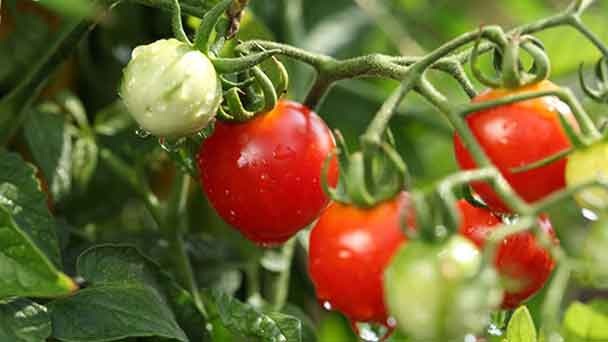
Beefsteak Tomatoe is certainly not the most prolific or attractive. Commercially, Beefsteak Tomato accounts for only about 1% of the total crop, compared with nearly 50% for round tomatoes. Growing steak tomatoes requires more patience, as most varieties reach optimum size and perfect ripeness around 80 days after planting. The reward of Beefsteak Tomato is flavor: creamy, juicy, and rich with tomato flavor.
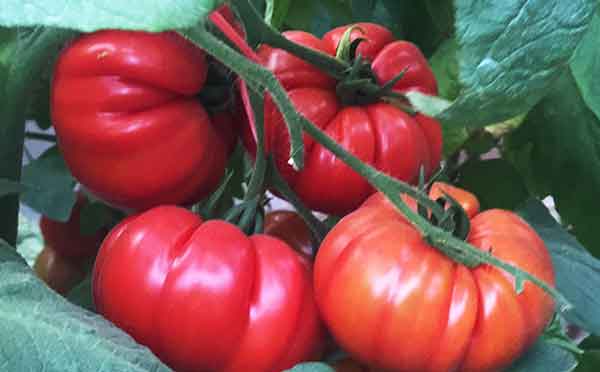
Start by germinating seeds indoors to protect the delicate seedlings from the cold.
The rule of thumb is to plant your tomatoes outside about two weeks after the last frost of the season, once soil temperatures are around 60°F.
Depending on where you live, the time to start germination will vary. Most people begin sowing their seeds in early March, so the seeds are ready for planting in early May.
You can begin germinating your seeds in flats or small parts. There are many ideal substrates you can use, such as seed starting soil, potting soil, or peat pellets.
Once you have your container and growing medium sorted out:
Place two beefsteak tomato seeds in each container.
You’ll want to plant them about three times as deep as the size of the seed. In most cases, this is about ¼ – ½” deep.
Place in an area with sunlight.
Water when the soil is dry.
Let the seedlings reach about eight inches tall before hardening them off.
Planting outdoors.
Your seedlings will germinate well if you keep them in a warm place that receives plenty of sunlight. After 7 – 14 days, your seeds will germinate and begin to grow.
While they will thrive in light for up to 16 hours per day, they need a dark period in order to grow. If using grow lights, don’t leave them on for 24 hours.
They'll also need to be hardened off before planting outside. Keep them outdoors for a week with some protection from hot sun and extreme temperatures.
After you've acclimated them to the outdoors for a week, you can plant them. Transplant seedlings into garden bed or right in the ground provided you have nutrient-rich soil.
You can also plant them in containers. Growing beefsteak tomatoes in pots outdoors is a way to keep predators away and also are ideal for smaller spaces or if you don't have a garden plot.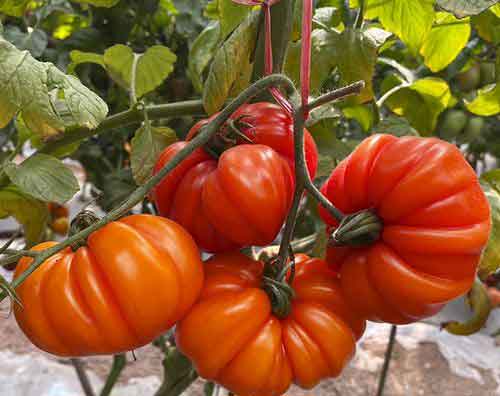
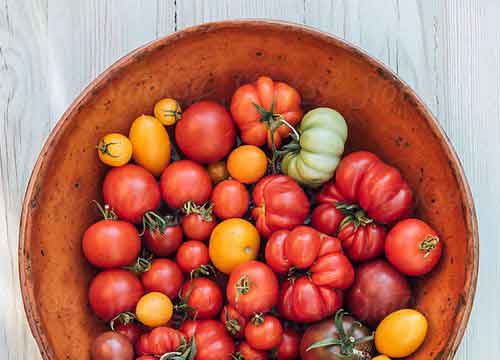
Additionally, You should feed these plants with compost and seaweed extract. It is needed only once every month.
Pruning
Because they are indeterminate, it's important to prune the suckers that form. Remove the growth that you see between the stem and branches. This will redirect the plant's energy into growing more tomatoes. Remove the suckers from the bottom of the plant, not higher up.
Read More: Why Are My Tomato Leaves Turning Yellow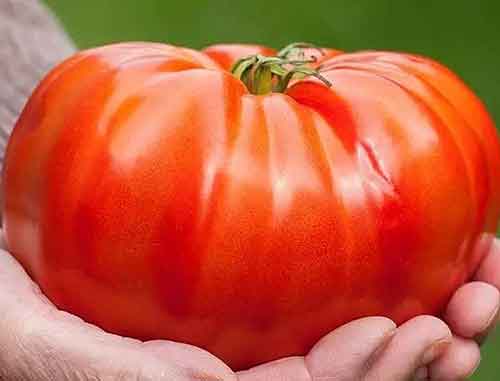
Support the plants with tomato cages, stakes or trellis them. Beefsteak tomatoes can weigh a pound or more at harvest time. Supporting the plant will allow them to focus energy on growing more tomatoes.
Where to Grow Beefsteak TomatoesWhen to Grow Beefsteak TomatoesHow to Grow Beefsteak Tomatoes from SeedsHow to Care for Beefsteak TomatoesBeefsteak Tomatoes Light RequirementsBeefsteak Tomatoes Soil CareBeefsteak Tomatoes WateringBeefsteak Tomatoes Temperature & Humidity CareBeefsteak Tomatoes FertilizerBeefsteak Tomatoes Pests & Diseases CareVarieties of Beefsteak TomatoesBeefsteak Tomatoes Care FAQWhy Do Beefsteak Tomatoes Split?How Tall Does a Beefsteak Tomato Plant Get?What is the Growth Time Of Beefsteak Tomatoes?What is the proper Space For Beefsteak Tomatoes?
Where to Grow Beefsteak Tomatoes
Growing Beefsteak Tomatoes in greenhouses gives you a longer growing season, and also reduces the risk of diseases such as blight, but Beefsteak Tomatoes can also be grown outside in a sheltered, sunny spot. They can be planted directly in the ground in rich, fertile, well-drained soil, or grown in pots filled with good multipurpose compost.When to Grow Beefsteak Tomatoes
It is a well-known fact that these tomatoes take a long time to grow and mature. Most importantly, No place especially in North America has sufficient long growing season for these steak beef tomatoes. So, you should prepare these beforehand. Generally, professional farmers and gardeners start their seedlings indoors in March. 20Feb to 30th March is ideal to start growing Beefsteak tomatoes in America. In Asia or Africa, It can be grown any time except the heavy monsoon season. It is a summer fruit vegetable in Italy and France. Always remember these tomatoes need a temperature nearly 20 degrees, below that, is not sufficient for germination.
How to Grow Beefsteak Tomatoes from Seeds
These tomatoes have a long growing season. In most parts of the country, the weather isn’t cooperative enough to grow beefsteak tomato plants entirely outdoors.Start by germinating seeds indoors to protect the delicate seedlings from the cold.
The rule of thumb is to plant your tomatoes outside about two weeks after the last frost of the season, once soil temperatures are around 60°F.
Depending on where you live, the time to start germination will vary. Most people begin sowing their seeds in early March, so the seeds are ready for planting in early May.
You can begin germinating your seeds in flats or small parts. There are many ideal substrates you can use, such as seed starting soil, potting soil, or peat pellets.
Once you have your container and growing medium sorted out:
Place two beefsteak tomato seeds in each container.
You’ll want to plant them about three times as deep as the size of the seed. In most cases, this is about ¼ – ½” deep.
Place in an area with sunlight.
Water when the soil is dry.
Let the seedlings reach about eight inches tall before hardening them off.
Planting outdoors.
Your seedlings will germinate well if you keep them in a warm place that receives plenty of sunlight. After 7 – 14 days, your seeds will germinate and begin to grow.
While they will thrive in light for up to 16 hours per day, they need a dark period in order to grow. If using grow lights, don’t leave them on for 24 hours.
They'll also need to be hardened off before planting outside. Keep them outdoors for a week with some protection from hot sun and extreme temperatures.
After you've acclimated them to the outdoors for a week, you can plant them. Transplant seedlings into garden bed or right in the ground provided you have nutrient-rich soil.
You can also plant them in containers. Growing beefsteak tomatoes in pots outdoors is a way to keep predators away and also are ideal for smaller spaces or if you don't have a garden plot.

How to Care for Beefsteak Tomatoes
Beefsteak Tomatoes Light Requirements
Beefsteak Tomato plant is very sun-loving. They need at least 8 hours of full sunlight. If you are living in a very crowded area with huge buildings, it might be a problem for you. Change the place of pots if there is any shadow of neighbors trees or buildings.Beefsteak Tomatoes Soil Care
Crop rotation is very necessary if you are growing beefsteak in a piece of land. The soil of pH around 6.5 (acidic) is most suitable to grow beefsteak tomato. Add some mulch of straw or winter cover crop in soil. It will keep the soil loose, which is good for the roots of tomato plants. Do not reuse the soil, if your previous crop has some kind of disease. Use some good quality potting mix. Because beefsteak tomatoes are a heavy feeder. So they need a good blend of organic matters, potassium, phosphorus, and nitrogen.Beefsteak Tomatoes Watering
Keeping your beefsteak tomatoes well watered is a must, especially once they set fruit. Moisture is critical to prevent cracked fruits and blossom end rot, and watering your beefsteak tomatoes deeply will encourage deep root systems. If it rains less than 1 inch per week, be sure to water your plants to make up the difference because tomatoes need a constant supply of moisture.Beefsteak Tomatoes Temperature & Humidity Care
Plant beefsteak tomatoes when temperatures are above 55 degrees Fahrenheit or ideally above 60 degrees. Since they are warm-weather crops, even a light frost can damage plants. In the event of a potential frost or temperature dip, cover the plants with a frost blanket.
Beefsteak Tomatoes Fertilizer
Feed the beefsteak tomato plants with NPK 19:19:19 for the first two weeks. Later balance the dose with NPK 8:32:16. Give only 4-8 granules of the fertilizer once every week for the first 2 weeks. Feed the plants with 15-20 granules once in 15 days starting from the third week of the final transplant.Additionally, You should feed these plants with compost and seaweed extract. It is needed only once every month.
Pruning
Because they are indeterminate, it's important to prune the suckers that form. Remove the growth that you see between the stem and branches. This will redirect the plant's energy into growing more tomatoes. Remove the suckers from the bottom of the plant, not higher up.
Beefsteak Tomatoes Pests & Diseases Care
- Blossom End Rot
- Tomato Blight
- Tomato Leaf Mould
- Tomato Splitting & Cracking
Read More: Why Are My Tomato Leaves Turning Yellow
Varieties of Beefsteak Tomatoes
Beefsteak tomato varieties produce fruits in many colors, including red/burgundy, gold/yellow, green, orange, pink, purple/lavender, and variegated. 'Beefmaster,' 'Big Beef,' and 'Big Boy' are among the most popular and easy to find varieties that have adapted to southern heat. 'Mortgage Lifter' and 'Grosse Lisse' are good choices for very humid areas. if you enjoy heirloom varieties, try 'Red Brandywine', 'Pruden's Purple Tomato', also known as 'Prudence', or 'Chocolate Stripes'.
Beefsteak Tomatoes Care FAQ
Why Do Beefsteak Tomatoes Split?
One of the problems with growing larger tomatoes is sometimes they split open. It's common for many tomato varieties including beefsteak tomato to split. While it isn't ideal, it's completely natural and nothing to be alarmed about. Tomatoes split most commonly when the fruit itself is growing faster than its skin will allow. Periods of heavy rain followed by dry weather can often cause tomatoes to split on the vine.How Tall Does a Beefsteak Tomato Plant Get?
Most beefsteak tomato varieties will grow to three feet or higher. Some can grow 6 – 8 feet tall. It's important to give them space as they can spread anywhere from one and a half to four feet wide.Support the plants with tomato cages, stakes or trellis them. Beefsteak tomatoes can weigh a pound or more at harvest time. Supporting the plant will allow them to focus energy on growing more tomatoes.
What is the Growth Time Of Beefsteak Tomatoes?
There are many kinds of varieties of beefsteak tomatoes. All of them have different growth times. But the average growth time of beefsteak varieties is 85 days. It means you can harvest your first biggest tomato in 85 days.What is the proper Space For Beefsteak Tomatoes?
These beefsteak tomatoes can grow up to 8 feet. That is why they are the best to grow in pots. No need for big land. But you will need some trellis to hold the plant. Or you can simply put the pot near to a wall so the plant can use the wall as support. But if the wall blocks the sunlight, don't do that. You can make your own DIY trellis using woods, PVC pipes or livestock cage. Or you can simply buy trellis from the online store.Latest Updated
- How To Save Your Sunburned Tomato Leaves
- Beefsteak Tomatoes Grow & Care Guide
- Beefsteak Tomatoes Profile
- Why Are My Orchid Leaves Turning Yellow - Common Causes & Fixs
- Hong Kong Orchid Tree Problems: Diseases And Remedies
- Hong Kong Orchid Tree Pros And Cons - How Fast Does It Grow
- Why Is My Orchid Stem Turning Yellow - How to Treat
- How to Grow and Care for Cymbidium Orchid (Boat Orchids)
- Why Do My Hibiscus Leaves Turn Yellow - Should I Cut Off Them
- Why Are My Tomato Leaves Turning Yellow - 7 Reasons & Solutions
Popular Articles
- Winter maintenance of Antirrhinum Majus
- How to Grow Terminalia Mantaly Tree
- How to Grow and Care for Crossostephium Chinense
- How to grow Antirrhinum Majus in spring
- Peristeria Elata (Dove Orchid) Profile: Info & Care Guide
- Underwatered Snake Plant (Sansevieria Trifasciata) - Signs And How To Fix
- How to Care for Brazilian Jasmine Plant (Mandevilla Sanderi)
- Rosa Chinensis (China Rose): Plant Growing & Care Tips
- How to Grow & Care for Graptopetalum Purple Delight in Summer
- How to Care for Baby Sun Rose (Aptenia Cordifolia)